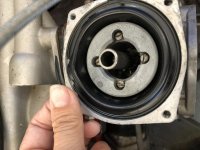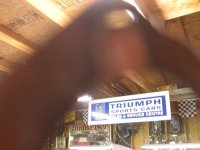Sorry: Extremely lengthy post to follow. Most of it covers carb adjustments for the early carbs. If I could find a succinct summary online I would have posted a link instead. I considered a PM to UmmYeal but this information may prove useful to others someday.
UmmYeah, I only recently saw that there is supposed to be a difference between the early 150CD diaphragms and those used in the later carbs. Like Wayne says, the later diaphragms will fit the early carbs. Just get diaphragms for 150CD carbs from a good source. You may pay more but give Joe Curto a call and he can supply what you need and the parts will be high quality. I assume Joe can also provide the three o-rings needed during the carb rebuild. From the picture I assume this is yet another place the local shop cut corners or didn't know what needed to be done. Some of the steps below wouldn't normally be necessary since your carbs were just serviced but I have questions about what that local shop may or may not have done.
I didn't really want to go on and on about the tuning of the 150CD carbs but it may be necessary. The problem you experienced with the sticking carb will have to be addressed when you get the replacement diaphragms.
Let's start with the basics.
Take the carbs off the car and separate them from each other (disconnect the linkages).
Remove their float bowls.
Use a wrench to remove the big brass hex body that is normally below the float bowl.
Remove the jet, jet bushing, spring, aluminum washer, and brass washer that the brass hex body was holding in place.
Inspect the hole in the center of the jet. It should be 0.090" in diameter, its hole should NOT appear oval. You may get some measurements with vernier calipers but checking the inside diameter with pin gauges would be better (but who has them at home?).
If the hole in the jet is at all oval, has any raised burrs or apparent scratches... replace the jets and needles with new. (again... Joe Curto).
Remove the 4 screws that hold the suction chamber (top of carb) onto the body.
Remove the suction chamber, the spring, and the air piston with the diaphragm.
Look at the needle. Is its shoulder flush with the underside of the piston? If not, loosen the screw on the side of the piston's bottom and adjust the needle until its shoulder is flush then retighten the screw. (A small steel ruler can be helpful to make sure the needle shoulder is flush with the bottom of the piston).
At the other end of the piston, remove the four Fillister head screws that secure the collar holding the diaphragm in place.
Remove the collar and the diaphragm.
Clean the carb body, air piston, and suction chamber if they are not already clean.
Look at the picture linked below, then look at your carbs' diaphragm and the top of the piston.
http://images.lotuselan.net/lel/55381/1/diaphragm.jpg
NOTE THE TABS on the diaphragm. You will find mating recessed slots on both the carb body and the top of the air piston.
Put a diaphragm on the air piston so the tab goes into the slot on the piston.
Refit the collar and four Fillister head screws and tighten the screws.
Place the piston back in the carb body making sure to align the diaphragm's remaining tab with the corresponding recessed slot at the top of the carb body.
Place the carb spring in the air piston.
Spray a little WD-40 on the center of the air piston and the hole in the center of the suction chamber.
Refit the suction chamber and its four securing screws. Tighten the screws.
Do NOT fit the damper back to the carb yet. Remove it if already installed.
Continue with the next steps to center the jet.
Lubricate and place a new o-ring in the jet bushing.
Refit the jet components to the carb body in the following order: Aluminum washer, jet bushing with o-ring, brass washer, heavy spring, jet, hex body (with lubed new o-ring installed), jet adjusting screw (with new lubed o-ring installed).
Tighten the hex body until it is fully seated then back it out 1 turn.
Tighten the jet adjusting screw (the sort of knurled brass knob on the bottom of the carb) all the way in or at least until you see the tip of the jet above the bridge (flat surface in the carb throat).
Hold the carb in its normal upright orientation. Remove the damper if installed.
Lift the air piston using your finger through the carb throat.
Drop the piston. It should fall to the bridge with a click. If it doesn't, lift and drop the air piston over and over again until it does fall sharply with a click.
Once the piston seems to be falling sharply to the bottom, use a wrench to start tightening the brass hex body.
Tighten the hex by one wrench flat at a time and each time repeat the piston lifting and dropping. Keep this up until the hex has been fully tightened AND the piston continues to fall sharply to the bridge. You may have to repeat this a couple of times to get the hang of it.
The jet is now centered and it is secured by your tightening of the hex.
Back the jet adjusting screw "down"/ "out" until the jet is just flush with the bridge (use a straight edge like a small stainless ruler to make sure it is flush).
At this point I make small paint marks to indicate the position of the jet adjusting screw relative to the hex body. This is clearly optional but it helps me keep track of turns during adjustment.
The factory manual says that from this position you should back the jet adjusting screw down/out 3 complete turns.
You can now refit the damper but wait to fill the piston with oil until the carbs are installed on the car.
The steps above will have assured that:
1) The jet and needle are OK (not worn oval, no burrs, no scratches).
2) The needle is correctly positioned on/in the air piston (needle shoulder flush with the piston bottom).
3) The diaphragm is correctly oriented with the carb body and the air piston (the tabs and recessed slots are aligned).
4) The jet is centered (the lifting and dropping of the piston results in a sharp click).
5) The jet has been adjusted down to the initial "start the engine" position from which the mixture can/must be tuned.
That's enough for one post. We can talk about the rest of the tuning sequence later. Again, I recommend Joe Curto for the parts.

 Hey there Guest!
Hey there Guest!
 smilie in place of the real @
smilie in place of the real @
 Pretty Please - add it to our Events forum(s) and add to the calendar! >>
Pretty Please - add it to our Events forum(s) and add to the calendar! >> 


 A friendly reminder - be careful what links you click on here. If a link is posted by someone you don't know, or the URL looks fishy, DON'T CLICK. Spammers sometimes post links that lead to sites that can infect your computer, so be mindful what you click.
A friendly reminder - be careful what links you click on here. If a link is posted by someone you don't know, or the URL looks fishy, DON'T CLICK. Spammers sometimes post links that lead to sites that can infect your computer, so be mindful what you click.